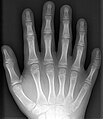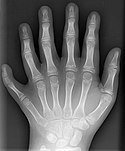Polidaktylia
Polidaktylia (polydaktylia) (gr. polýs – wiele, mnogi; dáktylos – palec) – wada wrodzona polegająca na obecności dodatkowego palca bądź palców, najczęściej I lub V.
Dodatkowe palce mogą być cechą zaburzeń chromosomowych (np. zespół Pataua), zaburzeń monogenowych autosomalnie dominujących lub o etiologii nieznanej. Polidaktylia może być wadą izolowaną lub stanowić część obrazu klinicznego wielu zespołów wad wrodzonych. Wśród rasy kaukaskiej jeden lub więcej dodatkowych palców stwierdza się u 1:2000 ludzi. Wada ta występuje 10 razy częściej u czarnoskórych niż u białych. Ogólna częstość występowania to 1:25000, co sprawia, że jest to najczęściej występująca wada kończyn górnych. Niekiedy występuje łącznie z palcozrostem (syndaktylia)[1].
Polidaktylia lewej ręki
Polidaktylia lewej stopy
Polydaktylia u 27-letniego mężczyzny; w palcu nie ma stawów, przez co pozbawiony jest możliwości ruchu
Znani ludzie z polidaktylią
- Henryk II Pobożny
- Władysław III Warneńczyk
- Anna Boleyn – druga żona króla Anglii, Henryka VIII (informacja niepewna)
- Hrithik Roshan – współczesny aktor z Bollywood
- Gemma Arterton – współczesna brytyjska aktorka. Zoperowane we wczesnym dzieciństwie.
- Raúl González Blanco – piłkarz (wieloletni kapitan Realu Madryt)
Zobacz też
- Syndaktylia
- Polidaktylia bazalnych czworonogów
Przypisy
- ↑ Opracowanie zbiorowe pod redakcją prof. dr. hab. Gerarda Drewy, Podstawy genetyki, ISBN 83-85564-60-8.
![]() Przeczytaj ostrzeżenie dotyczące informacji medycznych i pokrewnych zamieszczonych w Wikipedii.
Przeczytaj ostrzeżenie dotyczące informacji medycznych i pokrewnych zamieszczonych w Wikipedii.
Media użyte na tej stronie
The Star of Life, medical symbol used on some ambulances.
Star of Life was designed/created by a National Highway Traffic Safety Administration (US Gov) employee and is thus in the public domain.Autor: en:User:Drgnu23, subsequently altered by en:user:Grendelkhan, en:user: Raul654, and en:user:Solipsist, Licencja: CC-BY-SA-3.0
Conversion of a DICOM-format X-ray from a patient of en:User:Drgnu23, a ten year old male. This is the patient's right hand, anterior-posterior view. Identifying tags and such have been stripped. The image is his, released under the GFDL. The image was subsequently altered by en:user:Grendelkhan, en:user: Raul654, and en:user:Solipsist.
Autor: en:User:Drgnu23, subsequently altered by en:user:Grendelkhan, en:user: Raul654, and en:user:Solipsist., Licencja: CC-BY-SA-3.0
Conversion of a DICOM-format X-ray from a patient of en:User:Drgnu23, a ten year old male. This is the patient's right foot, anterior-posterior view. Identifying tags and such have been stripped. The image is his, released under the GFDL. The image was subsequently altered by en:user:Grendelkhan, en:user: Raul654, and en:user:Solipsist.
Autor: en:User:Drgnu23, subsequently altered by en:user:Grendelkhan, en:user: Raul654, and en:user:Solipsist, Licencja: CC-BY-SA-3.0
Conversion of a DICOM-format X-ray from a patient of en:User:Drgnu23, a ten year old male. This is the patient's left foot, anterior-posterior view. Identifying tags and such have been stripped. The image is his, released under the GFDL. The image was subsequently altered by en:user:Grendelkhan, en:user: Raul654, and en:user:Solipsist.
Autor: en:User:Drgnu23, subsequently altered by en:user:Grendelkhan, en:user: Raul654, and en:user:Solipsist., Licencja: CC-BY-SA-3.0
Conversion of a DICOM-format X-ray from a patient of en:User:Drgnu23, a ten year old male. This is the patient's left hand, posterior-anterior projection. Identifying tags and such have been stripped. The image is his, released under the GFDL. The image was subsequently altered by en:user:Grendelkhan, en:user: Raul654, and en:user:Solipsist.
Autor: en:user:ikkyu2, Licencja: CC-BY-SA-3.0
Polidaktylia u 27-letniego mężczyzny. W palcu nie ma stawów, przez co nie można nim ruszać.
Autor: Howie831, Licencja: CC BY-SA 3.0
Male kitten with 23 toes.












